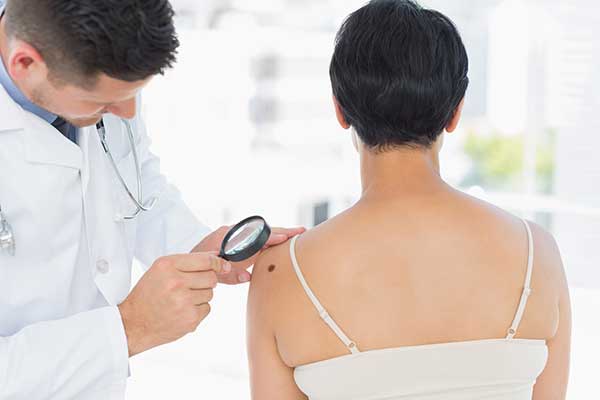Warm weather is FINALLY here, so now’s a good time to start thinking about protecting yourself from the sun’s ultraviolet rays. Dr. Omar Eton is the medical director of the Hartford HealthCare Cancer Institute Melanoma and Skin Center.
Q. When it comes to suspicious moles on our bodies, what should we be looking for?
A. Early detection is the key to cure. You have a front and a back and your significant other should inspect your back. Women have traditionally been better at detecting suspicious skin lesions but in 2018, it is time for the men to step up. Furthermore, there is an epidemic of melanoma in people over 60-65, especially in men. So they need to be more attentive to their bodies and to that of their loved ones. Taking a picture with a plastic ruler in the photo helps document measurements over time. The ABCDE’s of early detection of any skin cancer, especially melanoma should prompt a visit with a dermatologist or a primary care physician – these include:
- Asymetry
- Border irregularity
- Color variation: Melanomas are usually brown/black/blue, but can also be red. They can even be colorless.
- Diameter: The size of a pencil eraser head or larger
- Enlarged – Itching or bleeding
Q. Sunlight is a big factor when it comes to the development of skin cancer. Can can this type of cancer be found on parts of the body that rarely see sunlight?
A. While melanoma is prevalent especially in people of Northern European descent with fair skin and blue grey eyes – anyone can get melanoma, even of Mediterranean or African descent.
For folks who are black, melanoma is often a troubling surprise – found late on the bottom of the feet, between toes or in a nail bed under a toe nail. Melanoma can even show up inside the nose, in the genital area, or even in the intestinal tract. Melanoma can also appear in the eye. These variations exhibit different biology that modern scientists are busily sorting out.
Q. What is the best level of prevention?
A. Some SUN exposure is healthy; for example, in converting Vitamin D to its active form. Loose fitting clothing and a broad-brimmed hat may be adequate to ensure your skin stays healthy, unwrinkled, with less risk of skin cancer as you age. Excessive UV exposure from the sun, especially between 10 AM and 3 PM, is a rationale for using sun tan lotion – this is especially true for children. We recommend no more than SPF 30 for most. Higher SPF provides less incremental protection that necessary except in some familial syndromes and is expensive. Sun tan lotion needs to be applied as often as every two hours when out in the sun in a bathing suit. We strongly dissuade the use of tanning booths and there is a national campaign with laws already on the books banning tanning booth use, especially in our vulnerable youth and teenagers.
Hartford HealthCare physicians will offer a free visible skin check June 6 from 10 a.m. to 2 p.m. at Westfarms mall in West Hartford.
For more information or to make an appointment at the Melanoma and Skin Care Center, call 1.855.255.6181.

